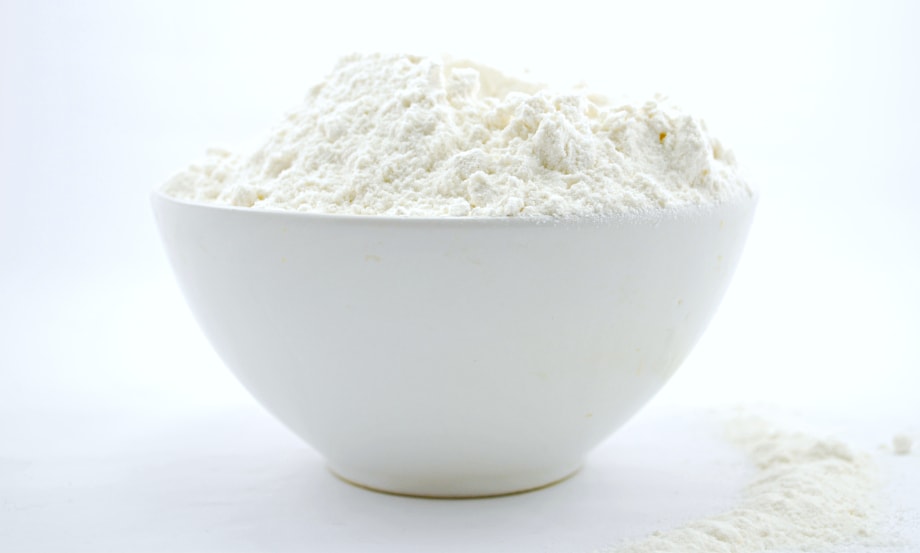When talking about the lowest calorie flour we have one major thing to consider in order to answer this question.
The lowest calorie flour can belong to two categories:
- grain flour
- grain-free flour or what we call flour substitutes or alternatives
Contents
My Picks for the Lowest Calorie Flours
1. Whole Wheat Flour: Bob’s Red Mill
Bob’s Red Mill Whole Wheat Flour is an amazing choice for the lowest calorie flour if you can eat gluten. According to their nutrition facts it has 368 calories per 3.5 oz (100 grams). That’s great. But what’s more important is the high quality of this flour. The only ingredient is whole grain hard red wheat, which is 100% stone ground. And the price is pretty good. It’s a wonderful choice that comes with two recipes on the package, for muffins and cookies.
2. Gluten-Free Bread Mix: Pamela’s Products
Gluten-free bread mixes are a bit expensive but Pamela’s Products Gluten-Free Bread Mix is absolutely awesome and makes delicious baked goods. It might be worth it if you just want a mix that’s completely ready to use. It has all the ingredients needed and it’s a blend of sorghum, tapioca, white rice, sweet rice, and brown rice flours. According to their nutrition facts, it has 363 calories per 3.5 oz (100 grams). For an even lower calorie content, check out King’s Arthur Measure for Measure Gluten-Free Flour.
3. Almond Flour: Simple Mills Almond Flour Baking Mix
When it comes to non-grains or flour substitutes, almond flour is one of the most famous because it’s just so easy to use, it can replace whole wheat flour on a 1:1 basis. It has a pretty high calorie content but it’s still a pretty perfect flour substitute. The Simple Mills Almond Flour Baking Mix Artisan Bread is a mix of almond flour, arrowroot, flax meal, tapioca starch, sea salt, and baking soda. There are 3 very simple recipes on the box for flatbread, dinner rolls, and loaf. The only con is the very high price but on the plus side it only contains 480 calories per 3.5 oz (100 grams). If you don’t want mixes but just plain almond flour, check out the options from Blue Diamond or Bob’s Red Mill.
Lowest Calorie Flours for Grain Flours (Gluten-Free Included)

Grain flour is obtained by milling the grains until they’re reduced to small particles. It can either contain gluten or be gluten-free.
There are two types of grain flour:
- grains with gluten – wheat flour, bread flour, all purpose flour, cake flour are the most used and well-known from this category but other grains include spelt, einkorn, barley, rye
- gluten-free grains – oat, quinoa, millet, brown rice, sorghum
How much do you want to bet that the lowest calorie flour is going to belong to the gluten-free grains category?
I’m pretty sure that no one wants to take on that bet because we all know instinctively that the low calorie flours made from grains are the gluten-free ones.
Well, we would be completely wrong.
Lowest Calorie Flour: Whole Wheat Flour
Whole wheat flour is our winner for the lowest calorie flour.
Whole wheat flour has 340 calories per 3.5 oz (100 grams). It is also a strong flour with a high protein content.
For those who can eat gluten, this one is the best option. We already knew that whole wheat breads are healthier and with a higher content of fiber. Now, we also know that it’s a low calorie flour.
There are advantages to using whole wheat flour for those who can eat gluten. Some of those advantages are: it’s easy to buy, it’s pretty affordable, it’s pretty easy to use, and you have millions of recipes for it.
There are books about bread full of interesting recipes so, those who are not on a gluten-free diet are indeed very lucky.
Whole wheat flour is also one of the best flours for sourdough. If you want to make sourdough starter and bread, whole wheat flour is an excellent option. You can also use rye flour. Or white bread flour.
I also want to mention that sourdough bread is vegan but 100% whole wheat breads can be made with milk and butter so you must pay attention to these things if you’re pursuing a certain lifestyle and diet.
All purpose flour is another low calorie flour. It has 354 calories per 3.5 oz (100 grams).
Low Calorie Gluten-Free Flours: Brown Rice Flour, Quinoa Flour & More
Quinoa flour has 357 calories per 3.5 oz (100 grams). That’s a pretty low calorie content. It’s also a source of complete protein, it provides all essential amino-acids.
So, the lowest calorie gluten-free flour is quinoa flour. There are other less known flours who have a low calorie content but quinoa flour is something that everyone has heard of.
You can buy quinoa flour or you can buy quinoa grains and make your own flour at home. You can make all types of flours at home, whether they’re made from grains or are alternatives.
However, it can be quite bitter for some people. simplyquinoa.com advises you to toast it if you find it bitter. It’s also a website where you will find a lot of recipes for it.
In my post on the best flour for bread machines, when it came to recommend gluten-free flours, I selected a brown rice flour. It turns out that I selected a low calorie flour without even looking because brown rice flour has 366 calories per 3.5 oz (100 grams).
Millet flour is another gluten-free flour with a low calorie content: 374 calories per 3.5 oz (100 grams).
Oat flour is another gluten-free flour that is pretty low in calories. It only has 400 calories per 3.5 oz (100 grams). It can be used to make amazing pancakes and cookies due to its pleasant nutty flavor, it’s also easily available and affordable but it can be made at home, too.
What About Gluten-Free Bread Mixes?
Gluten-free bread mixes are pretty low in calories and they contain a multitude of flours and are simply delicious.
One of the most popular, Pamela’s Gluten-Free Bread Mix contains 363 calories per 3.5 oz (100 grams).
King’s Arthur Measure for Measure Gluten-Free Flour contains only 322 calories. It’s lower than the lowest calorie flour, which is pretty weird but fantastic at the same time.
That’s impressively low so, you can buy gluten-free bread mixes without worry. They’re great in all aspects, except the price, some can be a bit expensive.
Flour Alternatives: Are there any Low Calorie Flour Substitutes?
Flour substitutes are flours that are made of anything else but grains. That would be the broad definition for them.
Unfortunately,
Flour alternatives are not exactly famous for being low in calories. Let me give you some examples that you can compare with the above low calorie flours.
One of the most famous flour alternatives is almond flour. It has a pretty high calorie content, 600 calories per 3.5 oz (100 grams). That’s a major difference if you compare it with the numbers that we’ve talked about above.
Almond flour is obtained from finely ground whole almonds, which are blanched in order to remove their skins. That’s why it’s also called blanched almond flour.
There is another type of flour obtained from almonds, which is called almond meal. The skins are not removed before grounding them.
There are major advantages to using almond flour. There’s a reason for which it is so famous.
And that reason is that it’s incredibly easy to use. For recipes with almond flour, check out dietdoctor.com.
Almond flour replaces whole wheat flour on a 1:1 basis in almost any recipes. It’s a direct substitute for whole wheat flour and that’s an amazing thing for those on a gluten-free diet.
That’s not the case with soy flour, which is indeed a pretty low calorie flour with 434 calories per 3.5 oz (100 grams).
Coconut flour has a very low calorie content when it comes to flour alternatives: 416 calories per 3.5 oz (100 grams).
I’s not as versatile as almond flour. And you need to like the taste of coconut if you’re going to use it to make bread. But it’s a fantastic alternative to almond flour for those who suffer from nut allergies.
You can substitute 1 cup of almond flour for 1/3 cups of coconut flour and see how that goes in recipes. Additional eggs might be needed.
Can the Lowest Calorie Flour Be Considered the Healthiest Flour?
We’ve talked about the lowest calorie flour for the two main categories of flours but which are the healthiest flours? Do they coincide?
The short answer is yes.
Before going into which are the healthiest flours, I just want to remind you that choosing whole grains over refined flours goes a long way in ensuring that you’re choosing the healthy option.
Whole wheat flour is a healthy flour and it can be easily substituted for white flour for those who want to eat healthier.
But substituting other flours might not be as easy and I’m talking about gluten-free flours. It’s why I recommended gluten-free bread mixes. Not only are they low in calories and delicious but they’re also easy to use for those who don’t care about reading how to substitute one flour for another and how to adjust the liquid and the cooking time.
Almond flour has a pretty high calorie count but it’s a healthy flour because it has a high concentration of protein and fats. Since it’s easy to use and can replace whole wheat flour on a 1:1 basis, it’s an amazing option for a lot of people.
Brown rice flour is also a healthy option due to its fiber content, oat flour is great for its protein content and healthy fats, and quinoa flour is famous for its essential amino acids.
My conclusion for the lowest calorie flour is this: those who can eat gluten have the best option in whole wheat flour and those who are on a gluten-free diet can try gluten-free bread mixes or they can experiment with any other of the low calorie flours because there are plenty.




